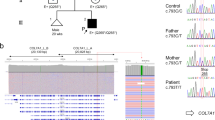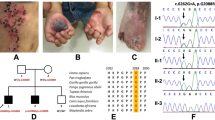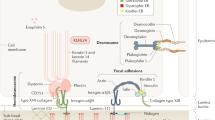Abstract
We report that mutation in the gene for plectin, a cytoskeleton–membrane anchorage protein, is a cause of autosomal recessive muscular dystrophy associated with skin blistering (epidermolysis bullosa simplex). The evidence comes from absence of plectin by antibody staining in affected individuals from four families, supportive genetic analysis (localization of the human plectin gene to chromosome 8q24.13–qter and evidence for disease segregation with markers in this region) and finally the identification of a homozygous frameshift mutation detected in plectin cDNA. Absence of the large multifunctional cytoskeleton protein plectin can simultaneously account for structural failure in both muscle and skin.
This is a preview of subscription content, access via your institution
Access options
Subscribe to this journal
Receive 12 print issues and online access
$209.00 per year
only $17.42 per issue
Buy this article
- Purchase on Springer Link
- Instant access to full article PDF
Prices may be subject to local taxes which are calculated during checkout
Similar content being viewed by others
References
Fine, J.-D. et al. Revised clinical and laboratory criteria for subtypes of inherited epidermolysis bullosa. J. Am. Acad. Derm. 24, 119–135 (1991).
Eady, R.A.J. & Dunnill, M.G.S. Epidermolysis bullosa: hereditary skin fragility diseases as paradigms in cell biology. Arch. Derm. Res. 287, 2–9 (1994).
Christiano, A.M. & Uitto, J. Molecular complexity of the cutaneous basement membrane zone. Revelations from the paradigms of epidermolysis bullosa. Exp. Derm. 5, 1–11 (1996).
Leigh, I.M. & Lane, E.B. Mutations in the genes for epidermal keratins in epidermolysis bullosa and epidermolytic hyperkeratosis. Arch. Derm. 129, 1571–1577 (1993).
Lane, E.B. Keratin diseases. Curr. Opin. Genet. Dev. 4, 412–418 (1994).
Niemi, K.M., Sommer, H., Kero, M., Kanerva, L. & Haltia, M. Epidermolysis bullosa simplex associated with muscular dystrophy with recessive inheritance. Arch. Derm. 124, 551–554 (1988).
Fine, J.-D. et al. Autosomal recessive epidermolysis bullosa simplex. Arch. Derm. 125, 931–938 (1989).
Doriguzzi, C. et al. Congenital muscular dystrophy associated with familial junctional epidermolysis bullosa lethalis. Eur. Neurol. 33, 454–460 (1993).
Wiche, G., Krepler, R., Artlieb, U., Pytela, R. & Denk, H. Occurrence and immunolocalization of plectin in tissues. J. Cell Biol. 97, 887–901 (1983).
Wiche, G., Krepler, R., Artlieb, U., Pytela, R. & Aberer, W. Identification of plectin in different human cell types and immunolocalization at epithelial basal cell surface membranes. Exp. Cell Res. 155, 43–49 (1984).
Foisner, R. et al. A panel of monoclonal antibodies to rat plectin: distinction by epitope mapping and immunoreactivity with different tissues and cell lines. Acta Histochem .(Jena) 96, 421–438 (1994).
Hieda, Y., Nishizawa, Y., Uematsu, J. & Owaribe, K. Identification of a new hemidesmosomal protein, HD1: a major high molecular mass component of isolated hemidesmosomes. J. Cell Biol. 116, 1497–1506 (1992).
McLean, W.H.I. & Lane, E.B. Intermediate filaments in disease. Curr. Opin. Cell Biol. 7, 118–125 (1995).
Legan, P.K., Collins, J.E. & Garrod, D.R. The molecular biology of desmosomes and hemidesmosomes: ‘what's in a name?’. BioEssays 14, 385–392 (1992).
Kurpakus, M.A. & Jones, J.C.R. A novel hemidesmosomal plaque component: tissue distribution and incorporation into assembling hemidesmosomes in an in vivo model. Exp. Cell Res. 194, 139–146 (1991).
Tanaka, T. et al. Production of rabbit antibodies against carboxy-terminal epitopes encoded by bullous pemphigoid cDNA. J. Invest. Derm. 94, 617–623 (1990).
Wiche, G. et al. Cloning and sequencing of rat plectin indicates a 466-kD polypeptide chain with a three-domain structure based on a central alpha-helical coiled coil. J. Cell Biol. 114, 83–99 (1991).
Kelsell, D.P. et al. Development of a panel of monochromosomal somatic cell hybrids for rapid gene mapping. Ann. Hum. Genet. 59, 233–241 (1995).
Liu, C.-G., Maercker, C., Castañon, M., Hauptmann, R. & Wiche, G. Human plectin: organization of the gene, sequence analysis, and chromosome localization (8q24). Proc. Natl. Acad. Sci. USA 93, 4278–4283 (1996).
Kelsell, D.P., Black, D.M., Bishop, D.T. & Spurr, N.K. Genetic analysis of the BRCA1 region in a large breast/ovarian cancer family: refinement of the minimal region containing BRCA1. Hum. Mol. Genet. 2, 1823–1828 (1993).
Cooper, D.N. Human gene mutation affecting RNA processing and translation. Ann. Med. 25, 11–17 (1993).
Cui, Y. Hagan, K.W., Zhang, S.A. & Peltz, S.W. Identification and characterization of genes that are required for the accelerated degradation of mRNAs containing a premature translational termination codon. Genes Dev. 9, 423–436 (1995).
Wiche, G., Plectin: General overview and appraisal of its potential role as a subunit protein of the cytomatrix. CRC Crit. Rev. Biochem. Mol. Biol. 24, 41–67 (1989).
Wiche, G. High-Mr microtubule-associated proteins: properties and functions. Biochem. J. 259, 1–12 (1989).
Jones, J.C. & Green, K.J. Intermediate filament-plasma membrane interactions. Curr. Opin. Cell Biol. 3, 127–132 (1991).
Foisner, R., Bohn, W., Mannweiler, K. & Wiche, G. Distribution and ultrastructure of plectin arrays in subclones of rat glioma C-6 cells differing in intermediate filament protein (vimentin) expression. J. Struct. Biol. 115, 304–317 (1995).
Wiche, G., Gromov, D., Donovan, A., Castanon, M.J. & Fuchs, E. Expression of plectin mutant cDNA in cultured cells indicates a role of COOH-terminal domain in intermediate filament association. J. Cell Biol. 121, 607–619 (1993).
Ishida-Yamamoto, A. et al. Epidermolysis bullosa simplex (Dowling-Meara type) is a genetic disease characterized by an abnormal keratin-filament network involving keratins K5 and K14. J. Invest. Derm. 97, 959–968 (1991).
Rugg, E.L. et al. A functional “knockout” of human keratin 14. Genes Dev. 8, 2563–2573 (1994).
McMillan, J.R. & Eady, R.A.J. Ontogeny of hemidesmosomes in human fetal digit skin. Arch. Derm. Res. 288, 91–97 (1996).
Campbell, K.P. Three muscular dystrophies: loss of cytoskeletal-extracellular matrix linkage. Cell 80, 675–679 (1995).
Guo, L. et al. Gene targeting of BPAG1: abnormalities in mechanical strength and cell migration in stratified epithelia and neurologic degeneration. Cell 81, 233–234 (1995).
Olaisen, B. & Gedde-Dahl Jr, T. GPT-epidermolysis bullosa simplex (EBS Ogna) linkage in man. Hum. Hered. 23, 189–196 (1973).
Brown, A., Bernier, G., Mathieu, M., Rossant, J. & Kothary, R. The mouse dystonia musculorum gene is a neural isoform of bullous pemphigoid antigen 1. Nature Genet. 10, 301–306 (1995).
Vaughan-Jones, S.A., Palmer, I., Bhogal, B.S., Eady, R.A.J. & Black, M.M. The use of Michel's transport medium for immunfluorescence and immunoelectron microscopy in autoimmune bullous diseases. J. Cut. Path. 22, 365–370 (1995).
Kennedy, A.R. et al. Abnormal binding of an anti-amnion antibody provides a novel diagnostic probe for junctional epidermolysis bullosa. Br. J. Derm. 113, 651–659 (1985).
Verrando, P. et al. Monoclonal antibody GB3 defines a widespread defect of several basement membranes and a keratinocyte dysfunction in patients with junctional epidermolysis bullosa. Lab. Invest. 64, 84–92 (1991).
Matsui, C. et al. γ2 chain of laminin 5 is recognized by monoclonal antibody GB3. J. Invest. Derm. 105, 648–652 (1995).
Sonnenberg, A., Janssen, H., Hogervorst, F., Calafat, J. & Hilgers, J. A complex of platelet glycoproteins Ic and IIa identified by a rat monoclonal antibody. J. Biol. Chem. 262, 10376–10383 (1987).
Kennel, S.J. et al. Second generation monoclonal antibodies to the human integrin alpha 6 and beta 4. Hybridoma 9, 243–255 (1990).
Fine, J.-D., Horiguchi, Y. & Couchman, J.R. 19-DEJ-1, a hemidesmosome-anchoring filament complex associated monoclonal antibody. Arch. Derm. 125, 520–523 (1989).
Bancroft, J.D. & Stevens, A. Theory and practice of histological techniques (Churchill Livingstone, London, 1996).
Richardson, K.C., Jarret, L. & Finke, E.H. Embedding in epoxy resins for ultrathin sectioning in electron microscopy. Stain Technol. 35, 313–323 (1960).
Eady, R.A.J. in Methods in Skin Research (eds Skerrow, D. & Skerrow, C. J.) 1-36 (John Wiley& Sons, Chichester, 1985).
Shimizu, H., McDonald, J.N., Kennedy, A.R. & Eady, R.A.J. Demonstration of intra- and extracellular localization of bullous pemphigoid antigen using cryofixation and freeze substitution for post-embedding immunoelectron microscopy. Arch. Derm. Res. 281, 443–448 (1989).
Pearson, W.R. & Lipman, J.D. Improved tools for biological sequence comparison. Proc. Natl. Acad. Sci. USA 85, 2444–2448 (1988).
Parrish, J.E., Wang, Y., Wagner, M.J. & Wells, D.E. Alignment of physical and genetic maps of human 8q23–qter using a somatic cell hybrid mapping panel. Somat. Cell Genet. 20, 143–146 (1994).
Cottingham, R.W., Idury, R.M. & Schaffer, A.A. Faster sequential genetic linkage computations. Am. J. Hum. Genet. 53, 252–263 (1993).
Gache, Y. et al. J. Clin. Invest. 97, 2289–2298 (1996).
McLean, W.H.I. et al. Loss of plectin causes epidermolysis bullosa with muscular dystrophy: cDNA cloning and genomic organization. Genes Dev. (in the press).
Author information
Authors and Affiliations
Rights and permissions
About this article
Cite this article
Smith, F., Eady, R., Leigh, I. et al. Plectin deficiency results in muscular dystrophy with epidermolysis bullosa. Nat Genet 13, 450–457 (1996). https://doi.org/10.1038/ng0896-450
Received:
Accepted:
Issue Date:
DOI: https://doi.org/10.1038/ng0896-450
This article is cited by
-
Roles of dystonin isoforms in the maintenance of neural, muscle, and cutaneous tissues
Anatomical Science International (2024)
-
Analysis of DNA methylation associates the cystine–glutamate antiporter SLC7A11 with risk of Parkinson’s disease
Nature Communications (2020)
-
Stabilizing mutations of KLHL24 ubiquitin ligase cause loss of keratin 14 and human skin fragility
Nature Genetics (2016)
-
FAM83H and casein kinase I regulate the organization of the keratin cytoskeleton and formation of desmosomes
Scientific Reports (2016)
-
Molecular architecture and function of the hemidesmosome
Cell and Tissue Research (2015)



